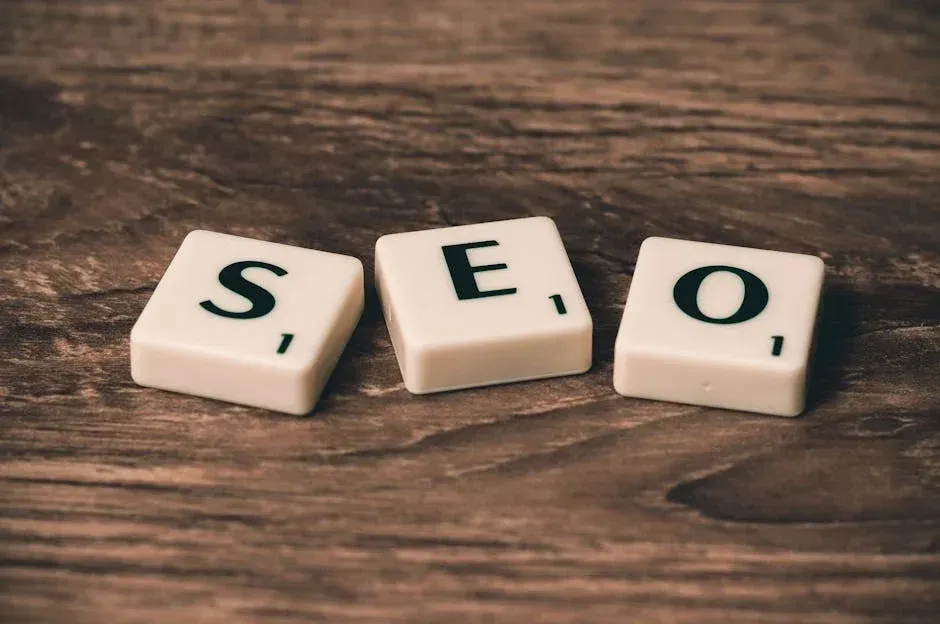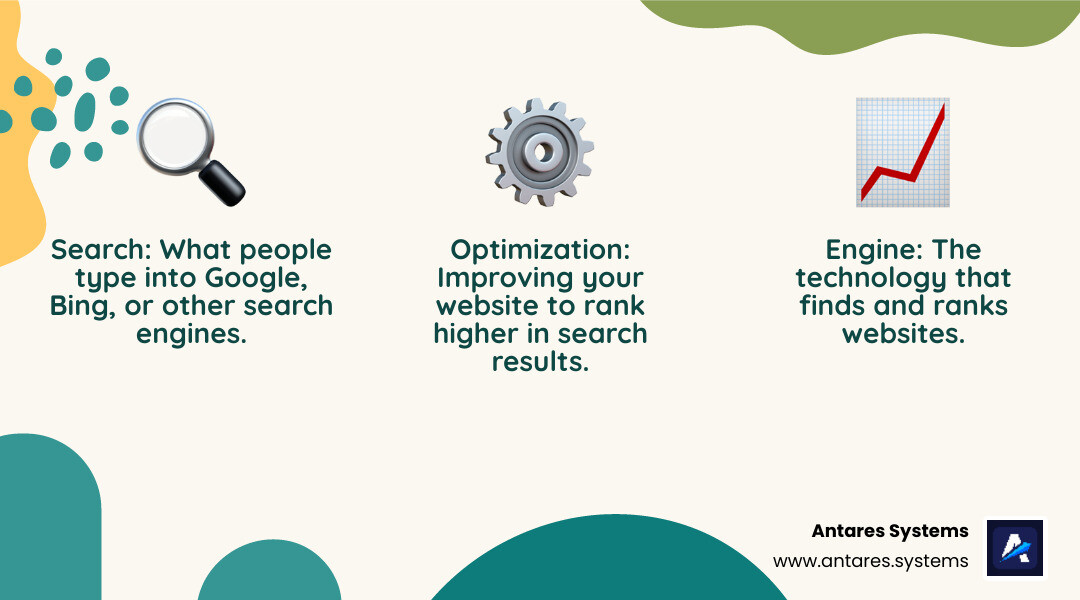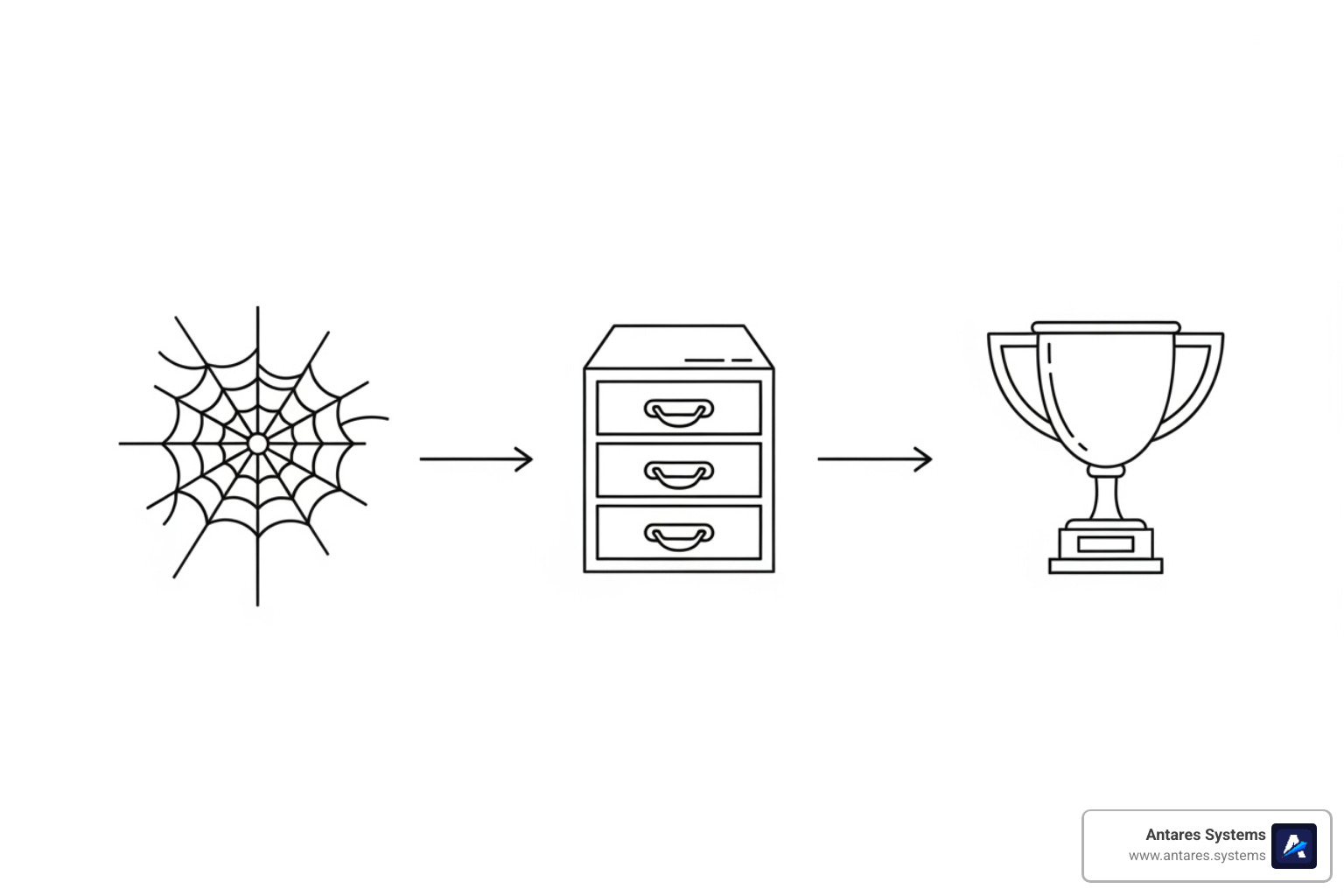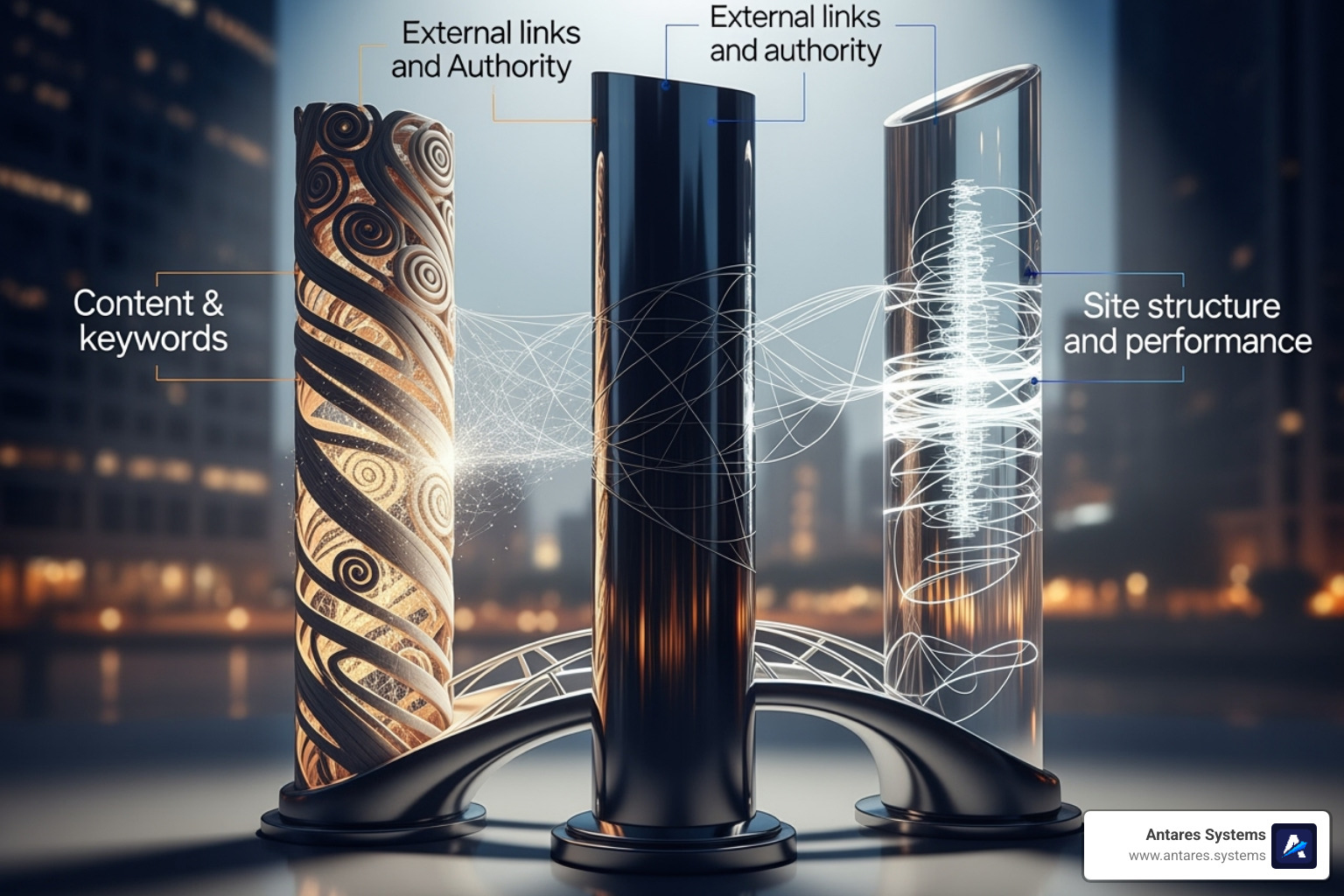Beyond the Acronym: Understanding What SEO Means for Your Business

What Does SEO Stand For? Your Gateway to Online Success
What does seo stand for? It's a common question for business owners, and the answer is your key to online visibility.
SEO = Search Engine Optimization
- Search: What your customers type into Google.
- Engine: The technology (like Google) that ranks websites.
- Optimization: The process of improving your site to rank higher.
In short, SEO is how you improve your website to get more organic (free) traffic from search engines. If you're a business owner in the Rio Grande Valley struggling with online visibility, you're not alone. While most people use search engines to find local services, 75% of users never scroll past the first page of results. If you're not on page one, you're missing out on valuable leads every day.
Understanding what SEO means is the first step toward fixing this. As an SEO Account Manager at Antares Systems, I've seen how a solid SEO strategy transforms a business's online presence by combining technical expertise with practical business goals.

What Does SEO Stand For? The Definition and Primary Goal
When business owners ask what does SEO stand for, they're asking how to tap into a powerful way to grow their business online.
More info about What is SEO? Maximizing Online Visibility
So, what does SEO stand for?
SEO stands for Search Engine Optimization. It's the ongoing process of making your website more appealing to search engines like Google (which holds about 83% of the global search engine market share ) and to your potential customers. The goal is to earn non-paid traffic through organic clicks, connecting you with people actively searching for your services.
The Primary Goal of SEO: More Than Just Rankings
While ranking high on Google is a great start, the true goal of SEO is to drive business results. For businesses in the Rio Grande Valley, a successful SEO strategy focuses on:
- Attracting Qualified Traffic: We don't want just any visitors; we want people genuinely interested in what you offer.
- Generating Leads and Sales: SEO connects you with prospects who have buying intent, making them more likely to convert.
- Building Brand Awareness and Trust: Appearing consistently in search results establishes your business as a credible authority in your field.
- Improving User Experience: Good SEO practices naturally lead to a faster, more user-friendly website, which benefits both your rankings and your customers.
How Search Engines Work: A Look Under the Hood
To understand what does SEO stand for, you need to know how search engines operate. Think of them as digital librarians for the entire internet. Google, with about 83% of the global search engine market share , uses a three-stage process to deliver relevant answers in seconds: crawling, indexing, and ranking.

Crawling and Indexing: Building the Library of the Web
First, automated programs called web crawlers or bots find content across the internet by following links. They analyze your pages—text, images, code—to understand what they're about. This information is then stored in a massive database called the website index. If your site isn't in the index, it can't appear in search results.
Ranking: Delivering the Most Relevant Results
When you perform a search, the engine's algorithm sifts through the index to find the best results. This is the ranking stage. It's a complex process that considers hundreds of ranking factors to determine which pages are most deserving of the top spots. Key factors include:
- Relevance: Does your content directly answer the user's query?
- Authority: Is your website a trustworthy and credible source, often signaled by links from other reputable sites?
- User Experience: Is your site fast, mobile-friendly, and easy to steer?
- Search Intent: Does your page match the user's goal (e.g., to learn, find a local business, or make a purchase)?
By creating content that aligns with these factors, you can improve your website's ranking. For a deeper dive, see our guide: How to Rank My Website on Google: 5 Steps.
The Core Components of a Winning SEO Strategy
A robust SEO strategy is built on three interconnected pillars: On-Page SEO, Off-Page SEO, and Technical SEO. Each one signals to search engines that your website is the best answer for a user's query.

On-Page SEO: Optimizing Your Content
On-Page SEO involves optimizing elements directly on your website. This includes:
- Keyword Research: Identifying the terms your customers use, like "AC repair McAllen."
- Content Quality: Creating high-quality, helpful content that answers user questions.
- Title Tags & Meta Descriptions: Crafting compelling headlines and summaries for search results.
- Header Tags: Organizing content with H1, H2, and H3 tags for readability.
- Internal Linking: Connecting related pages on your site to guide users and search engines.
Explore more strategies in our SEO Tips to Rank Your Website on Google 2024.
Off-Page SEO: Building Authority and Trust
Off-Page SEO refers to actions taken outside your website to build its reputation. Key activities are:
- Backlinks: Earning links from other reputable websites, which act as "votes of confidence."
- Link Building: The strategic process of acquiring these valuable links.
- Brand Mentions & Social Signals: Mentions of your brand and social media activity can indirectly boost visibility.
- Guest Posting: Writing for other industry blogs to earn links and establish expertise.
Learn how to dominate your local market with our Ultimate Guide to Growing Your Business with Local SEO.
Technical SEO: Ensuring a Solid Foundation
Technical SEO ensures your site's backend is optimized for search engines. This covers:
- Site Speed: Ensuring your website loads quickly to improve user experience and rankings.
- Mobile-Friendliness: Having a responsive design that works perfectly on all devices.
- Site Architecture: A logical site structure that's easy for users and crawlers to steer.
- Schema Markup: Adding structured data to help search engines understand your content.
- Security (HTTPS): A secure site builds trust and is a positive ranking signal.
- XML Sitemaps: A map that helps search engines find and index all your important pages.
SEO and Organic Search: How It Differs from Paid Advertising
While both SEO and paid advertising increase online visibility, they work very differently. Understanding the distinction is key for any business planning its digital strategy.
The Difference Between SEO and SEM
Organic Search (SEO)
Organic search refers to the unpaid, "earned" rankings that appear based on relevance and authority.
- Cost: No charge per click, but requires an investment in time and expertise.
- Results: Takes weeks or months to see results, but they are sustainable and long-lasting.
- Trust: Users often have higher trust in organic results compared to ads.
- Traffic: Traffic can grow over time and doesn't stop when you stop paying.
Paid Search (PPC) - For Context
Paid search, or pay-per-click, involves paying for ad placement at the top of search results.
- Cost: You pay for every click or impression.
- Results: Delivers instant traffic and visibility.
- Trust: Some users may skip over results clearly marked as "Ad."
- Traffic: Visibility disappears the moment you stop funding the campaign.
Note: Antares Systems specializes in SEO and organic growth strategies to build long-term, sustainable online visibility. Our core focus is on driving organic success for our clients.
Why SEO is Crucial for Your Business in the Age of AI
The rise of artificial intelligence is reshaping how people search online, making a strong SEO foundation more critical than ever. For businesses in McAllen, San Antonio, and beyond, adapting to this new era is key to staying visible.
What is E-E-A-T and Why It Matters
Google's E-E-A-T framework is central to modern SEO. It prioritizes content that demonstrates:
- Experience: Real, hands-on experience with the topic.
- Expertise: Proven knowledge and skill.
- Authoritativeness: Recognition as a leader in your field.
- Trustworthiness: Accuracy, security, and transparency.
This is especially vital for Your Money or Your Life(YMYL) topics like home repair or legal services. As noted in Google's SEO Starter Guide: The Basics , content that aligns with E-E-A-T naturally performs better.
How AI is Reshaping SEO Strategies
AI is changing search behavior and SEO tactics:
- AI Overviews: AI-generated summaries at the top of search results prioritize clear, well-structured, authoritative content.
- Conversational & Voice Search: People are using more natural, question-based queries, requiring content that provides direct answers.
- AI-Powered Tools: We leverage AI to analyze trends and identify content opportunities, allowing us to focus on high-level strategy.
Basic SEO Best Practices for Content Creation
Even in the age of AI, the fundamentals remain the same:
- Write for people first: Create helpful, original content that answers user questions.
- Use clear headings and descriptive URLs: Make your content easy for both humans and search engines to understand.
- Target the right keywords: Focus on the terms your local customers are actually using.
Learn more about finding the right terms in our guide: Target Local Keywords to Increase Your Business Visibility.
AI isn't making SEO obsolete; it's making quality and expertise more important than ever.
Tracking Your Success: How to Measure SEO Performance
Effective SEO isn't just about implementing strategies—it's about measuring their impact on your business growth. We track performance to ensure our optimizations are delivering clear, measurable results.
How to Perform a Local SEO Audit for Your Business
Key Metrics to Monitor
We focus on metrics that tell the story of your online success:
- Organic Traffic: The number of visitors finding your site through unpaid search.
- Keyword Rankings: Your position in search results for target keywords.
- Click-Through Rate (CTR): The percentage of people who click your link in search results.
- Bounce Rate: The percentage of visitors who leave after viewing only one page.
- Conversions: The number of visitors who take a desired action, like calling or filling out a form.
- Backlink Profile: The quantity and quality of sites linking to yours, indicating authority.
Essential Tools for SEO Tracking
To manage these metrics, we use a combination of powerful tools:
- Google Search Console: Shows how Google sees your site, including search queries and technical issues.
- Google Analytics: Provides insights into user behavior on your website.
- Bing Webmaster Tools: Monitors performance on Microsoft's search engine.
- Professional SEO Software: Used for advanced keyword research, competitor analysis, and technical audits.
By tracking this data, we can see how SEO efforts translate directly into a stronger, more visible business.
Turn SEO Knowledge into Business Growth
Now you know the answer to what does SEO stand for and how it can transform your business. While the details can seem complex, the core concept is simple: connect with customers when they need you most.
SEO is a long-term investment that builds sustainable growth. Unlike temporary ads, a strong SEO foundation delivers qualified traffic, more leads, and improved brand trust for years to come. For service-based businesses in the Rio Grande Valley—from McAllen to Brownsville—a smart SEO strategy is the key to moving from struggling for leads to having a steady stream of customers find you online.
At Antares Systems, we specialize in AI-powered marketing solutions that handle the complexities for you. Our Local SEO services are designed for local contractors, lawyers, and other service providers who want to grow without becoming SEO experts.
You focus on running your business; we'll handle making sure customers can find you. Don't let the technical details hold you back.
Ready to turn SEO knowledge into real business growth? We're here to help you open up your full online potential.









